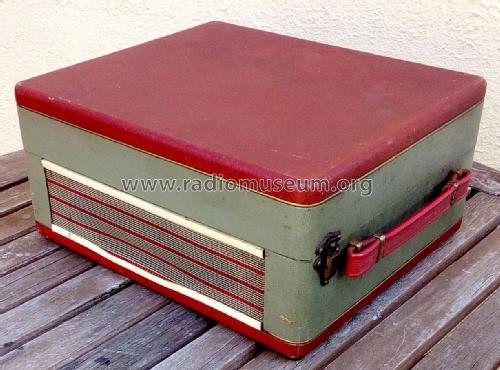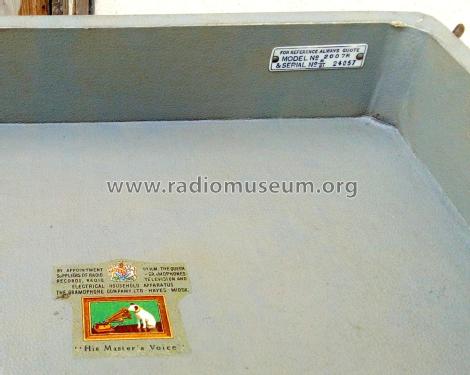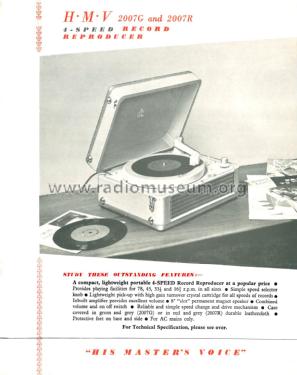4 Speed Record Reproducer 2007G 2007R
HMV (Brand), His Masters Voice, The Gramophone Company Ltd.; Middlesex
- Country
- Great Britain (UK)
- Manufacturer / Brand
- HMV (Brand), His Masters Voice, The Gramophone Company Ltd.; Middlesex
- Year
- 1957 ?
- Category
- Sound/Video Recorder and/or Player
- Radiomuseum.org ID
- 323343
Click on the schematic thumbnail to request the schematic as a free document.
- Number of Tubes
- 1
- Valves / Tubes
- UL84
- Main principle
- Audio-Amplification
- Wave bands
- - without
- Details
- Rec.Player+Audio.Amp+LS
- Power type and voltage
- Alternating Current supply (AC) / 220-250 Volt
- Loudspeaker
- Permanent Magnet Dynamic (PDyn) Loudspeaker (moving coil) - elliptical
- Material
- Leather / canvas / plastic - over other material
- from Radiomuseum.org
- Model: 4 Speed Record Reproducer 2007G 2007R - HMV Brand, His Masters Voice,
- Shape
- Tablemodel without push buttons, Mantel/Midget/Compact up to 14
- Dimensions (WHD)
- 12 x 5.5 x 10.25 inch / 305 x 140 x 260 mm
- Notes
-
A 4 speed portable record player.
Styling:
The 2007G is green and grey
The 2007R is red and grey
It is extremely compact with no storage space for records or the mains plug.Four speeds: 16, 33, 45, 78 rpm.
A flipover cartridge (ceramic or crystal) with 78 and 33 (microgroove) stylii fitted. A spring and strip with holes is used to set tracking weight.
The speed selector must be set to off to release the idler wheel.
There are at least three versions of the circuit:
- Originally the UL84 heater was in series with the motor.
- A motor with a tap is used to power the UL84 heater.
- A 4.7 k Ohms series resistor and 0.1µF capacitior for the screen grid, pin 9. A 220 pF capacitor from the volume control input to output. The 1.5 M Ohm R3 is omitted. The audio transformer primary has an additional unused intermediate tap.
Warning: The chassis is live and connected to the external metal work via a 1nF paper dielectric capacitor. This should be replaced with a 1nF to 5nF 1kV XY rated part for safety. There is only a lightweight two core flex.
- Net weight (2.2 lb = 1 kg)
- 8.5 kg / 18 lb 11.6 oz (18.722 lb)
- Literature/Schematics (1)
- - - Manufacturers Literature (HMV 2007G 2007R brochures)
- Author
- Model page created by Michael Watterson. See "Data change" for further contributors.
- Other Models
-
Here you find 424 models, 334 with images and 242 with schematics for wireless sets etc. In French: TSF for Télégraphie sans fil.
All listed radios etc. from HMV (Brand), His Masters Voice, The Gramophone Company Ltd.; Middlesex
Collections
The model 4 Speed Record Reproducer is part of the collections of the following members.
Forum contributions about this model: HMV Brand, His: 4 Speed Record Reproducer 2007G 2007R
Threads: 1 | Posts: 1
I was surprised to see this in the local animal welfare charity shop. I thought it looked too large to be an attaché case radio and too small to be a record player. Though it was styled like many 1950s UK attaché case radio models.
Opening it revealed it was a record player. I was also surprised at the lack of hits online doing a search. The most similar model is the HMV RE.11.AM which might have replaced it. It's not on the Trader Sheets or R&TVS. The 2006 and 2008 are listed in R&TVS, but though they are record players, they are later. The 2006 seems later and more advanced than the 2008 as it's an optionally stereo, transistor model.
The wires had been pulled off the pickup. The stylus arms were bent around the tip of the cartridge. Connecting the 'scope revealed that the cartridge is working, so I removed it, pulled off connectors, cleaned the green corrosion of the pins and straightened the strips holding the styli. I re-soldered the cable to the clips with them still off the cartridge as soldering heat can damage it. The arm tracking weight spring was in the end hole of the retaining strip, so I moved it midway for now as that would have been greatest loading.
The dual 32 + 32 µF capacitor tested fine for leakage at 32V and discharged slowly on the PSU meter. The 3.3 kΩ main dropper resistor was fine.
The 100uF 10V two piece plastic case Plessey capacitor on the cathode resistor was dried out and replaced with a 35V 106 °C 100uF part. There was also a 0.1 µF paper dielectric capacitor on the screen grid to chassis with an associated 4.7 kΩ series resistor to HT. It was leaky and replaced with a 630V polyester type. The chassis end of both original capacitors was left connected. The selenium rectifier was left in place and a 4 way screw terminal block used its pins to mount a 1N4007. No additional series resistance is needed in this design.
The 1nF 1 kV paper dielectric capacitor between the electrical chassis, which could be either side of the mains, and the main turntable base was snipped where it connected to the chassis end of the volume control. This didn't have R3, 1.5 MΩ, but did have a simple loudness feature implemented by a 220 pF silver mica capacitor between input and output.
Powered on. Nothing, not even hum. The HT was OK and the UL84 heater was glowing. A known good one was substituted, but there was no change.
The nut driver is needed to take out the two retaining nuts. Examination revealed that the cathode and grid pins where bent and soldered together! Strange. The solder was removed and pins bent apart. The input screened cable then needed reconnecting to the grid pin. There is no grid leak resistor or series capacitor no doubt to save two parts and the bias is set by the cathode resistor.
Now it badly played the 78. The volume control was strange. Fixed by spraying in some WD40 at the terminals, it dries to leave a thin wax film, which is why it's a bad lubricant. The speed issue and noise from the platter was due to the idler being totally perished.
I tried supergluing a synthetic O ring around it as the actual diameter isn't critical. But it made it too fat. Then I remembered I'd dismembered a cheap scrap Currys reel to reel taperecorder at the same time as restoring two others. Could one of its idler wheels fit?
It was like in new condition despite the heads on that machine being badly worn away. The thickness seemed OK as did the diameter. Perhaps a shade thicker, but the poor condition made it hard to tell.
The original had two metal shim washers and a fibre washer under it. Moving the fibre washer to the top made the edge match the speed steps on the motor shaft. The internal diameter and boss height was the same!
Now it played 33, 45 and 78 perfectly and the noise was gone from the platter. No doubt the two styli are sapphire and worn, but it depends how much it was used.
It's not very loud, but I don't know it's due to having only a single UL84, a worn out cartridge or the 160V HT. There is no voltage adjustment. Our mains is typically about 230V here in Ireland, but most English people I know seem to have a little more than 240V. The other UL84 is loud in the radio and is not actually as loud in the record player. However it sounds quite good for such a simple turntable and amplifier.
Michael Watterson, 13.Aug.20







